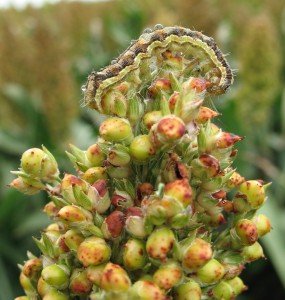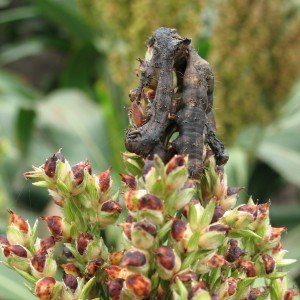Helicoverpa populations have started with a bang this season. One or more larvae per plant are common in pre-flowering sorghum, corn and cotton. However, early flowering sorghum crops are carrying up to 10 larvae per head. Corn and sorghum (monocot crops) host only Helicoverpa armigera, not H. punctigera – which has implications for control. Some key issues relevant to dealing with a high pressure Helicoverpa season are discussed below.
Helicoverpa in vegetative sorghum
Research has shown that foliar damage will have no impact on crop yield or earliness (See – No concern for tell-tale holes https://thebeatsheet.com.au/?p=13 ).

Helicoverpa larva on sorghum
This season, the combination of high yield potential in sorghum and the high early helicoverpa pressure, makes it is worth considering whether these early populations warrant control.
In general, helicoverpa control in sorghum targets larvae on the flowering head, before they reach 13 mm in length, and this is largely achieved using NPV. The decision to treat is guided by calculating the economic threshold which incorporates pest pressure and the value of the crop. (See -Thresholds and changing sorghum crop value – https://thebeatsheet.com.au/?p=33).
NPV will control up to 90% of larvae, and under high pressure this may still leave damaging numbers of larvae. However, it is unlikely that any other product will be more effective.
Whilst the economic return on earlier applications of NPV are not proven, they may reduce the risk of larvae surviving and causing significant damage to sorghum when it starts flowering and filling grain. The use of reduced rates of NPV (down to half the full rate), banding and combined application with herbicide makes a risk reduction approach more financially viable. Reduced rates of NPV have been shown to be highly effective against helicoverpa, particularly against larvae less than 7 mm in length.

Helicoverpa in vegetative corn
As with sorghum, helicoverpa larvae feeding on corn foliage will not cause any loss of yield or earliness. However, larger larvae which have developed on the foliage or in the tassel boot, may cause damage to the early developing ear. Both small and larger larvae will feed on the young silks, resulting in reduced pollination of the cob. Ear damage from helicoverpa larvae is unlikely to cause significant yield loss, but can increase the incidence of fungal infections on the developing grain, particularly under wet conditions.
There are a number of options for controlling helicoverpa larvae in corn, including NPV, pyrethroids and carbamates. In making decisions about control, consider larval size, the likelihood of insecticide resistance and the benefits of preserving natural enemies (parasitoids like Trichogramma spp.) which are often abundant in maize.
(see – Chemigation for corn earworm control, https://thebeatsheet.com.au/?p=191)
Applying NPV where rain is forecast
The ongoing wet weather raises questions about how best to time NPV applications when rain is expected. NPV is significantly more effective against smaller larvae, so delaying application can impact on performance.
However, rainfall following an application generally has no impact on NPV performance, or may even have a positive impact on NPV performance (NPV is spread by rainfall splash). So do not delay an application if light to moderate rain is expected. Where very heavy rainfall is expected within one hour after application, it is advised to delay application until conditions improve, as there is a risk of the virus being washed off the crop before being ingested by the larvae.
Article by Anthony Hawes and the DEEDI entomology team
